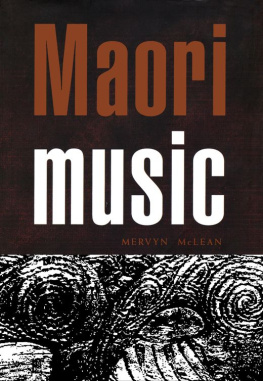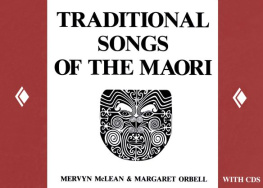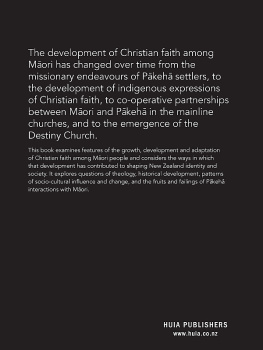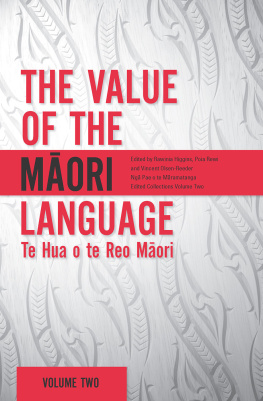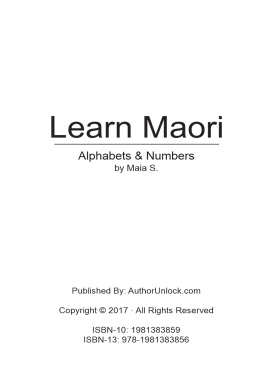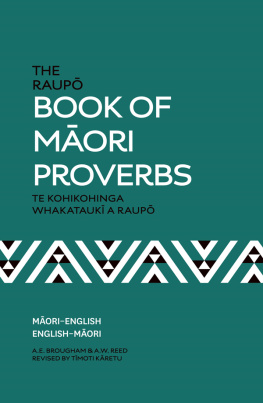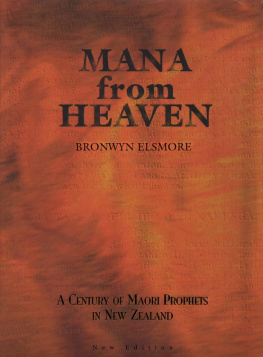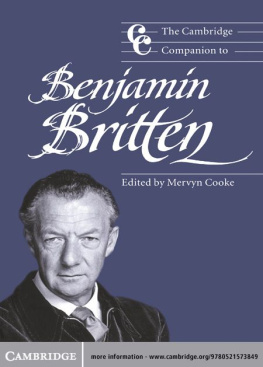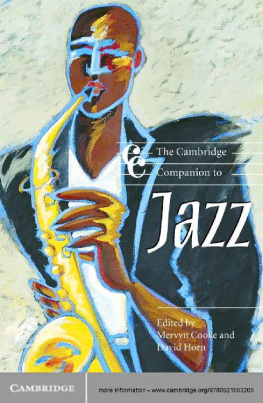Mervyn McLean - Maori Music
Here you can read online Mervyn McLean - Maori Music full text of the book (entire story) in english for free. Download pdf and epub, get meaning, cover and reviews about this ebook. year: 2012, publisher: Auckland University Press, genre: Home and family. Description of the work, (preface) as well as reviews are available. Best literature library LitArk.com created for fans of good reading and offers a wide selection of genres:
Romance novel
Science fiction
Adventure
Detective
Science
History
Home and family
Prose
Art
Politics
Computer
Non-fiction
Religion
Business
Children
Humor
Choose a favorite category and find really read worthwhile books. Enjoy immersion in the world of imagination, feel the emotions of the characters or learn something new for yourself, make an fascinating discovery.
- Book:Maori Music
- Author:
- Publisher:Auckland University Press
- Genre:
- Year:2012
- Rating:5 / 5
- Favourites:Add to favourites
- Your mark:
- 100
- 1
- 2
- 3
- 4
- 5
Maori Music: summary, description and annotation
We offer to read an annotation, description, summary or preface (depends on what the author of the book "Maori Music" wrote himself). If you haven't found the necessary information about the book — write in the comments, we will try to find it.
Maori Music — read online for free the complete book (whole text) full work
Below is the text of the book, divided by pages. System saving the place of the last page read, allows you to conveniently read the book "Maori Music" online for free, without having to search again every time where you left off. Put a bookmark, and you can go to the page where you finished reading at any time.
Font size:
Interval:
Bookmark:
To
Arapeta Awatere (19101976)
and
Hoani Halbert (18901958)
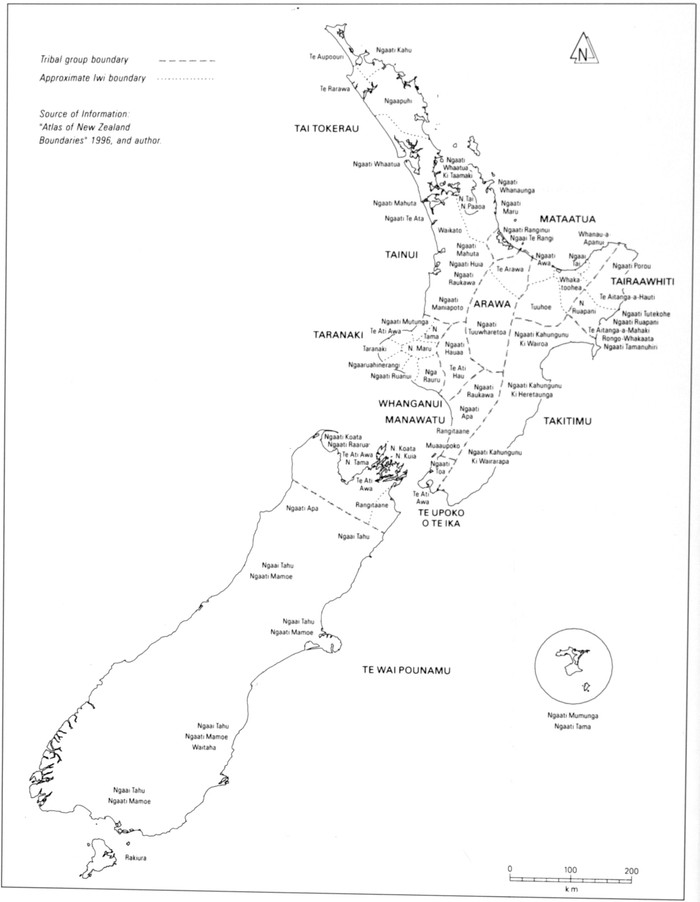
Map of Tribal Distribution
In a 1983 article, Anne Salmond offers a critique of assumptions underlying the common distinction made between traditional and modern forms of Maori life. She makes the point that:
judgements of what is traditional have differed for each generation of scholars and bits and pieces of information from anywhere between 1769 and 1969 have been cobbled together in accounts of traditional behaviour that included practices which never would have coexisted in any given Maori community at any given time.
In Salmonds view, traditional has been unduly equated with precontact, and Maori society has been falsely represented both as functioning in equilibrium until European contact and shattered beyond redemption after contact took place. Other criticisms of the standard accounts are that too little attention has been paid to regional diversity, chronological control has been lacking, and segmentation of Maori society into discrete topics such as economics , religion, art, music, warfare and marriage cuts across tribal ways of understanding the past. Her solution to these perceived failings, now exemplified in her own award-winning book TwoWorlds (1991), is to make use of written records in both English and Maori, together with oral accounts, to give a better understanding of how tribal life has changed in historic times.
The present work takes a necessarily topical approach. One hopes, nevertheless , that Salmonds several points have been accommodated. The last of them was taken aboard by ethnomusicologists decades ago with the publication of Alan P. Merriams book TheAnthropologyofMusic (1964) and its then new concept of ethnomusicology as the study of music in culture. From Chapter 1 onwards, the present book treats music as integral with, rather than isolated from, Maori society. Also, in every section of the book the approach is both diachronic and synchronic to the extent that the data allow . Sources of information, both written and oral, are very diverse. The writers own field work began in 1958 and continued for more than 20 years: some 1300 resulting recorded songs together with hundreds of pages of interviews with singers have provided a solid core for the study. From travel, missionary, historical and ethnographic literature have come numerous eye-witness statements and observations about music over a span of 200 years. Archaeological and other scientific evidence has been drawn upon as appropriate . Transcription and analysis of the recorded songs have provided further insights. There are gaps in the information, but a surprisingly coherent picture has emerged of Maori music as it is and was.
A&M | HymnsAncientandModern (Baker 1861) |
AMPM | Archive of Maori & Pacific Music, Anthropology Department, University of Auckland |
Cyl | Numbers with this prefix refer to items in McLean & Curnow 1992b |
DNZB | DictionaryofNewZealandBiography (v.l W. Oliver et al. 1990; V.2 Orange et al. 1993) |
McL | Numbers with this prefix refer to McLean collection, Archive of Maori & Pacific Music. For a catalogue see McLean & Curnow 1992a |
McLean & Orbell | McLean & Orbell, TraditionalSongsoftheMaori (1975) |
M&O | Song numbers in McLean & Orbell |
| MPFB | Maori Purposes Fund Board |
| NM | Song numbers in Ngatas NgaMoteatea (Ngata 1959, 1990; Ngata & Te Hurinui 1961, 1970) |
| NZNB | New Zealand National Bibliography (Bagnall 196985) |
| NZBS | New Zealand Broadcasting Service |
| RNZA | Radio New Zealand Archives |
| W | H. Williams, ABibliographyofPrintedMaorito1900 (1924) |
| Williams | H. Williams, ADictionaryoftheMaoriLanguage (1975) |
In the musical examples, conventional Western notation is used, with the following additional symbols:
[ ] = added
( ) = omitted
= note to be sharpened by up to a quarter tone
= note to be flattened by up to a quarter tone
(on note stem) = gradual continuous ascent of pitch
(on note stem) = gradual continuous descent of pitch
(on note stem) = ascent of pitch followed by a fall
In recited compositions, where phrases are marked, there is usually a rise of pitch around the middle of a phrase followed by a fall at the end, whether or not this is shown by arrows.
 = spoken or of indeterminate pitch
= spoken or of indeterminate pitch
 = portamento between notes
= portamento between notes
 = upward glissando
= upward glissando
 = downward glissando
= downward glissando
 = wavering note
= wavering note
 = short rest
= short rest
 = dotted barline: structural subdivision, not necessarily followed by an accent as in Western music
= dotted barline: structural subdivision, not necessarily followed by an accent as in Western music
 = grace notes: these take their time from the notes to which they are tied
= grace notes: these take their time from the notes to which they are tied
A quirk of the computer software used for the music examples causes the phrase marks used in the music examples to be unclosed at the beginning. In all music examples, for  read
read 
Nearly all of the musical examples are transcriptions from the writers own field recordings. An accompanying CD of the examples was suggested by Auckland University Press as a useful supplement to the book; however, unfortunately this cannot be provided because of assurances given to singers that their songs would not be issued as recordings for sale. Bona fide researchers or Maori groups requiring specific recordings for learning purposes can obtain them by writing to the Archive of Maori and Pacific Music, University of Auckland.
For Maori terminology relating to music the writer has relied primarily on information from singers, supplemented by reference to H.W. Williamss A DictionaryoftheMaoriLanguage, 7th edition (1975). names of organisations and Maori words which have entered English, such as the word Maori itself, vowel length has been left unmarked or unaltered. For all other Maori words, long vowels are marked in the present work by doubling; in Williams and most other publications they are indicated by macrons. In conformity with Auckland University Press house style, Maori words in the present work are not italicised, and -s is not added for plural forms, including words such as Maori which are commonly used in English.
Font size:
Interval:
Bookmark:
Similar books «Maori Music»
Look at similar books to Maori Music. We have selected literature similar in name and meaning in the hope of providing readers with more options to find new, interesting, not yet read works.
Discussion, reviews of the book Maori Music and just readers' own opinions. Leave your comments, write what you think about the work, its meaning or the main characters. Specify what exactly you liked and what you didn't like, and why you think so.

